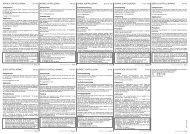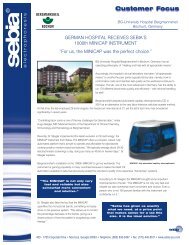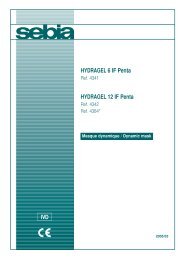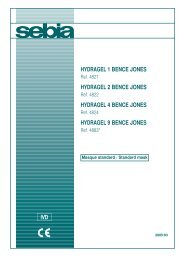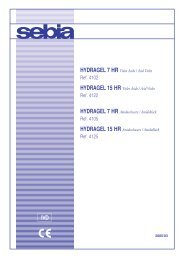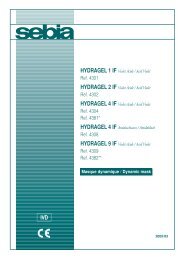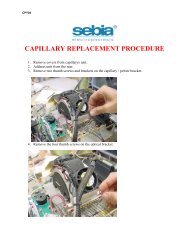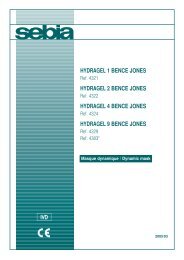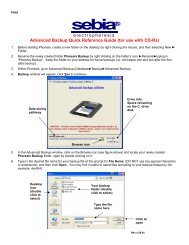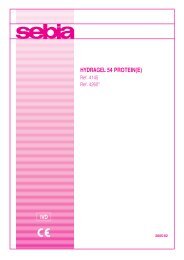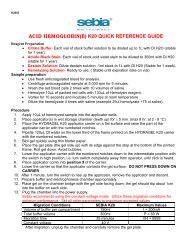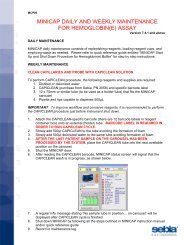CAPILLARYS HEMOGLOBIN(E)
CAPILLARYS HEMOGLOBIN(E) - Sebia Electrophoresis
CAPILLARYS HEMOGLOBIN(E) - Sebia Electrophoresis
- No tags were found...
You also want an ePaper? Increase the reach of your titles
YUMPU automatically turns print PDFs into web optimized ePapers that Google loves.
<strong>CAPILLARYS</strong> <strong>HEMOGLOBIN</strong>(E) - 2010/10<br />
Storage, stability and signs of deterioration<br />
Store CAPICLEAN refrigerated (2 - 8 °C). It is stable until the expiration date indicated on the vial label. DO NOT FREEZE.<br />
CAPICLEAN must be free of precipitate. Discard CAPICLEAN if it changes its appearance, e.g., becomes cloudy due to microbial contamination.<br />
4. SODIUM HYPOCHLORITE SOLUTION (for sample probe cleaning)<br />
Preparation<br />
Prepare a sodium hypochlorite solution (2 % to 3 % chloride) by diluting 250 mL 9.6 % chloride concentrated solution to 1 liter with cold distilled or<br />
deionized water.<br />
Use<br />
For the sample probe cleaning in the <strong>CAPILLARYS</strong> System (weekly maintenance in order to eliminate adsorbed proteins from the probe).<br />
See the instruction sheets of <strong>CAPILLARYS</strong>, SEBIA.<br />
• Use the sample rack designed for the maintenance (No. 100).<br />
• Place a tube containing 2 mL diluted chlorinated solution previously prepared, in position No. 1 on this sample rack.<br />
• Slide the sample rack No. 100 for maintenance in the <strong>CAPILLARYS</strong> System.<br />
• In the "MAINTENANCE" window which appears on the screen, select "Launch the probe cleaning (chlorinated sodium hypochlorite solution)" and<br />
validate.<br />
Storage, stability and signs of deterioration<br />
Store the working chlorinated solution at room temperature in a closed container, it is stable for 3 months. Avoid storage in sunlight, close to heat and<br />
ignition source, and to acids and ammonia.<br />
5. <strong>CAPILLARYS</strong> / MINICAP WASH SOLUTION<br />
Preparation<br />
Each vial of the stock Wash Solution (SEBIA, PN 2052, 2 vials, 75 mL) should be diluted up to 750 mL with distilled or deionized water.<br />
WARNING: See the safety data sheet.<br />
Use<br />
For washing the capillaries of <strong>CAPILLARYS</strong>. This additional reagent is needed when the number of tests in series is below 40.<br />
IMPORTANT: Before filling the wash solution container, it is recommended to wash the opening of the container, the connector and the tube with plenty<br />
of distilled or deionized water to avoid salts deposit.<br />
Storage, stability and signs of deterioration<br />
Store the stock and working wash solutions in closed containers at room temperature or refrigerated.<br />
The stock wash solution is stable until the expiration date indicated on the kit or wash solution vial label.<br />
Working wash solution is stable for 3 months.<br />
Discard working wash solution if it changes its appearance, e.g., becomes cloudy due to microbial contamination.<br />
6. SALINE<br />
Preparation<br />
Make 0.15 M (0.9 g/dL) NaCl solution in distilled or deionized water.<br />
Use<br />
To wash red blood cells before storage at - 80 °C, if necessary.<br />
Storage, stability and signs of deterioration<br />
Store saline at room temperature or refrigerated. Discard after 3 months or if it changes its appearance, e.g., becomes cloudy due to microbial<br />
contamination. For longer storage periods, add sodium azide, 0.1 g/dL.<br />
OPTIONAL REAGENT (SOLD SEPARATELY)<br />
Hb AFSC CONTROL<br />
Composition<br />
The Hb AFSC Control (SEBIA, PN 4792) is obtained from a pool of human blood samples with normal hemoglobins A and F and abnormal hemoglobins<br />
S and C. The Hb AFSC Control is in a stabilized lyophilized form.<br />
Intended use<br />
The Hb AFSC Control is designed for the quality control of electrophoretic separations of human hemoglobins with the <strong>CAPILLARYS</strong> CORD BLOOD<br />
procedure. It should be used as normal human blood.<br />
It is recommended to include the Hb AFSC Control into each series of analysis.<br />
Reconstitute the Hb AFSC Control vial with the exact volume of distilled or deionized water, as indicated in the package insert of the Hb AFSC Control.<br />
Allow to stand for 30 minutes and mix gently (avoid formation of foam).<br />
Quality control using the sample rack No. 0 : The Hb AFSC Control should be used as follows :<br />
- Apply the reconstituted Hb AFSC Control in a microtube.<br />
- Cut the cap of the microtube.<br />
- Place the microtube, located on a new hemolyzing tube used as a support, in position No. 1 on the <strong>CAPILLARYS</strong> sample rack No. 0 intended for<br />
control blood sample, and a new dilution segment.<br />
IMPORTANT: For optimal use of the Hb AFSC Control, it is necessary to use one bar code label intended to identify the hemolyzing tube holding<br />
the microtube which contains the Hb AFSC Control (cut the cap of the microtube before using it).<br />
- Pour 4 mL of <strong>CAPILLARYS</strong> <strong>HEMOGLOBIN</strong>(E) hemolyzing solution in a hemolyzing tube without introducing air bubbles and place it in position No. 8<br />
on the sample rack No. 0.<br />
IMPORTANT: Ensure the absence of foam in the tube before placing it on the sample rack.<br />
- Start the analysis : Slide the sample rack No. 0 into the <strong>CAPILLARYS</strong> system, select "automatic dilution" in the window which appears on the screen<br />
and validate.<br />
The results are then automatically considered by the software for the data analysis.<br />
- 59 -



